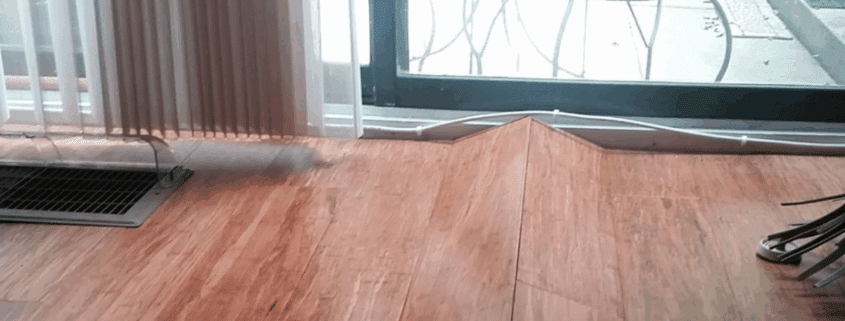How Florida’s Humidity Affects Your Flooring and What to Do About It
As a Florida homeowner, you’re no stranger to the challenges our unique climate presents. While our sunshine state offers beautiful weather and outdoor living opportunities, the persistent high humidity can wreak havoc on one of your home’s most significant investments – your floor. At Frogs Floor Care, we’ve been helping Lakeland and Tampa Bay area residents protect and maintain their floors against humidity damage since 1992, and we’ve seen firsthand how moisture can affect every type of flooring.
Whether you have carpet, hardwood, laminate, or tile, Florida’s humidity presents specific challenges that require specialized knowledge and preventative measures. In this comprehensive guide, we’ll explore how our state’s high moisture levels impact different flooring types and provide practical strategies to protect your investment.
Understanding Florida’s Humidity Challenge
Florida’s average relative humidity typically ranges between 70-90% throughout the year, significantly higher than the ideal indoor humidity level of 30-50% recommended for healthy home environments. This consistently high humidity creates unique challenges for Lakeland homeowners that residents in drier climates simply don’t face.
The combination of high humidity and changes in temperature and humidity between air-conditioned interiors and hot exteriors creates the perfect environment for moisture problems. When warm, humid air contacts cooler surfaces inside your home, condensation forms – and your floor is often the first victim of this moisture accumulation.
As Geoffrey Odermatt, owner of Frogs Floor Care and a fifth-generation Floridian explains, “Living in Florida’s humid environment means accepting humidity as part of life, but that doesn’t mean your floors have to suffer. Understanding how Florida’s humidity affects different flooring materials is the first step in protecting your investment.”
How Humidity Affects Different Flooring Types
Carpet and Humidity
The Problem: High humidity levels can wreak havoc on carpeted floors in several ways:
- Mold and mildew growth – Carpet fibers trap moisture, creating an ideal environment for mold spores to thrive, especially in the carpet padding underneath
- Musty odors – Even before visible mold appears, humidity can increase odor development
- Dust mite proliferation – These microscopic allergens thrive in humid conditions
- Carpet backing deterioration – Prolonged exposure to moisture can break down adhesives and cause carpet to separate from its backing
- Increased allergens – Humid carpets trap more dust, pollen, and other allergens
As our Lakeland customers have discovered, carpet that feels slightly damp to the touch is already experiencing significant moisture issues that require immediate attention.
Warning Signs:
- Musty or sour odors, especially in less-ventilated rooms
- Carpet that feels damp underfoot
- Increased allergy symptoms when at home
- Visible mold spots (usually black, green, or white discoloration)
- Carpet backing visible from the surface due to separation
Hardwood Flooring and Humidity
The Problem: Hardwood flooring is particularly vulnerable to Florida’s humidity because wood is a natural material that reacts to changes in temperature and humidity. Wood floor planks absorb moisture from the air and expand when humidity levels rise.
This moisture absorption and expansion can cause:
- Cupping – The edges of the boards become higher than the centers
- Crowning – The centers of the boards rise higher than the edges
- Buckling – The most severe response where boards actually detach from the subfloor
- Warping and distortion – Boards that twist or warp out of shape
- Finish damage – Clouding, bubbling, or peeling of floor finishes
Many Lakeland homeowners are surprised to learn that even engineered hardwood, while more stable than solid hardwood, isn’t immune to humidity damage in Florida’s unique climate with consistently high humidity.
Warning Signs:
- Visible gaps between boards during drier seasons
- Boards that appear raised at the edges (cupping)
- Squeaking or creaking sounds when walking on the floor
- Visible warping or buckling of boards
- Finish appearing cloudy or bubbled
Laminate Flooring and Humidity
The Problem: While laminate flooring was designed to be more moisture-resistant than hardwood, it’s still vulnerable to Florida’s extreme humidity levels. The core of most laminate flooring is made of high-density fiberboard (HDF), which can expand and contract when exposed to excess moisture.
Humidity damage to laminate typically manifests as:
- Swollen edges – Creating a peaked appearance where boards meet
- Separation between planks – As materials expand and contract with humidity changes
- Warping and bubbling – Especially in areas where moisture accumulates
- Discoloration – Often appearing as white or cloudy areas
- Complete failure – Where boards become so damaged they must be replaced
We’ve seen many Lakeland homes where laminate flooring installed without proper humidity considerations has failed within just 1-2 years of installation.
Warning Signs:
- Visible peaking at the seams between boards
- Bubbling or warping on the surface
- Edges of planks that appear darker or discolored
- Soft or spongy areas when walking
- Visible mold along the edges
Tile and Grout in Humid Environments
The Problem: While ceramic and porcelain tile are among the most humidity-resistant flooring options (and a popular choice in Florida homes), the grout between tiles remains vulnerable:
- Mold and mildew in grout lines – The porous nature of standard grout makes it susceptible to mold growth
- Grout deterioration – Constant moisture can break down grout over time
- Loosening tiles – In extreme cases, excess water can seep beneath tiles and affect the adhesive
- Efflorescence – A white, powdery substance that appears when water evaporates and leaves mineral deposits
- Subfloor damage – Moisture that penetrates through damaged grout can affect the substrate below
As our professional tile cleaning experts have observed, many Lakeland homeowners focus on cleaning the tile surface but neglect the more vulnerable grout lines where humidity causes the most damage.
Warning Signs:
- Discolored grout (usually black or green spots indicating mold)
- Crumbling or eroding grout
- Hollow sounds when tapping on tile (indicating loose adhesion)
- White, powdery residue on grout or tile surfaces
- Musty odors, especially in bathroom and kitchen areas
Vinyl Flooring and Humidity
The Problem: Modern vinyl flooring (including luxury vinyl tile and plank) is designed to be highly water-resistant, making it one of the better flooring options for Florida homes. However, excessive humidity can still cause issues:
- Adhesive failure – For glue-down vinyl, high humidity can affect adhesive performance
- Subfloor problems – Moisture can become trapped between the vinyl and subfloor
- Expansion and contraction – Leading to gaps or buckling in floating vinyl installations
- Mold underneath – While the vinyl itself resists mold, moisture can foster growth underneath
- Discoloration – Some vinyl products may discolor when exposed to constant moisture
Even with vinyl’s moisture resistance, proper installation with humidity considerations is essential for Florida homes.
Warning Signs:
- Bubbles or ripples in the flooring surface
- Edges curling up
- Seams that are lifting or separating
- Discoloration or staining that wasn’t caused by spills
- Musty smells indicating trapped moisture beneath the flooring
Prevention Strategies for Humidity-Related Floor Damage
Now that we understand how Florida’s humidity affects different flooring types, let’s explore practical preventive measures to protect your investment:
1. Control Indoor Humidity Level
The most effective way to prevent humidity damage is to maintain proper indoor humidity level in your home:
- Install and use a dehumidifier – Portable units work well for problem areas, while whole-house dehumidifiers provide comprehensive protection
- Maintain your air conditioning system – Regular maintenance ensures efficient moisture removal
- Use bathroom and kitchen exhaust fans – These provide proper ventilation to remove moisture at the source
- Consider a smart thermostat with humidity control – Modern systems can help maintain optimal humidity levels
- Monitor humidity level in your home – Inexpensive hygrometers can help you track moisture levels throughout your home
For Lakeland homes, maintaining indoor humidity level between 45-55% provides the best balance for floor protection while still being comfortable.
2. Choose Flooring Solutions Wisely
If you’re installing new flooring in your Florida home, consider humidity resistance as a primary factor:
- Engineered hardwood over solid hardwood (more dimensionally stable)
- Luxury vinyl plank or tile for wood-look options with superior moisture resistance
- Porcelain tile (less porous than ceramic) with sealed grout
- Cork flooring with proper sealing (naturally mold-resistant)
- Concrete with decorative treatments for a modern look with excellent humidity resistance
For carpet installations, consider products with synthetic fibers and moisture-resistant backing designed specifically for Florida’s humid climate.
3. Ensure Proper Acclimation During Installation
One of the biggest mistakes we see in Lakeland homes is improper acclimation of flooring materials before installation:
- Hardwood and laminate should acclimate in your home for at least 1-2 weeks before installation
- Allow for proper expansion gaps around the perimeter of wood, laminate, and vinyl installations
- Install appropriate moisture barriers to prevent water from seeping into the subfloor
- Test subfloor moisture content before installation
- Work with experienced Florida installers who understand our unique challenges with humidity
4. Implement Regular Maintenance Routines
Proactive maintenance is essential for combating humidity effects:
- Wipe up spills immediately on all flooring types
- Use HVAC systems consistently rather than turning them off when away
- Clean with appropriate products that don’t add excess moisture
- Mop with microfiber to minimize water on the floor
- Schedule regular professional deep cleaning for carpets, tile, and upholstery
- Inspect floors regularly for early signs of humidity damage
5. Address Potential Moisture Sources
Beyond ambient humidity, check for specific sources of moisture that could affect your floor:
- Repair any plumbing leaks promptly to prevent water intrusion, even minor ones
- Check for condensation on windows and pipes
- Ensure proper drainage around your home’s foundation
- Consider a vapor barrier in basement or crawl spaces
- Monitor indoor plants that can release significant moisture
- Pay special attention to high-traffic areas where moisture can be tracked in
Professional Solutions for Humidity-Damaged Floors
Even with preventative measures, Florida’s naturally high humidity may eventually cause issues. Here’s how Frogs Floor Care can help restore humidity-damaged floors:
For Carpet:
- Deep extraction cleaning – Our professional carpet cleaning service removes deeply embedded moisture and contaminants
- Anti-microbial treatments – Specialized treatments prevent mold and mildew growth
- Dehumidification – Industrial-grade equipment to thoroughly dry carpet and padding
- Odor removal – Specialized treatments eliminate musty smells caused by humidity
- Carpet pad replacement – When necessary to remove severely affected padding
For Hardwood and Laminate:
- Professional assessment – Determining the extent of humidity damage
- Deep cleaning – Removing contaminants without adding excessive moisture
- Refinishing options – For hardwood with humidity-damaged finishes
- Targeted repairs – Addressing specific damaged areas when possible
- Guidance on replacement – When humidity damage is too severe to repair
For Tile and Grout:
- Professional tile and grout cleaning – Deep cleaning that removes mold and mildew
- Grout sealing – Creating a moisture-resistant barrier
- Grout repair or replacement – For areas with significant deterioration
- Anti-microbial treatments – Preventing future mold growth
- Efflorescence removal – Eliminating mineral deposits caused by evaporating moisture
As Geoffrey Odermatt of Frogs Floor Care explains, “Professional intervention at the first signs of humidity damage can often prevent more costly repairs later. Our specialized equipment and techniques can address moisture issues that household cleaning simply can’t match.”
Protect Your Floors from Humidity for Long-Term Longevity
Florida’s humidity presents unique challenges for every type of floor, but with proper prevention strategies and professional maintenance, you can help maintain your floors looking their best for years to come.
At Frogs Floor Care, we’ve been helping Lakeland and Tampa Bay area homeowners protect their floors from humidity since 1992. Our certified technicians understand the specific challenges of Florida’s climate and provide specialized services to address humidity-related issues for all flooring types.
Whether you’re noticing the early signs of humidity damage or want to implement a preventative maintenance plan to protect your floors, we’re here to help. Contact us today at 813-960-3764 or 863-430-1030 to schedule a professional assessment of your floors and receive a customized plan to protect them from Florida’s challenging humidity.
And don’t forget – sign up for our newsletter to receive 20% off your first service and get monthly tips for maintaining beautiful, healthy floors in Florida’s unique climate!






